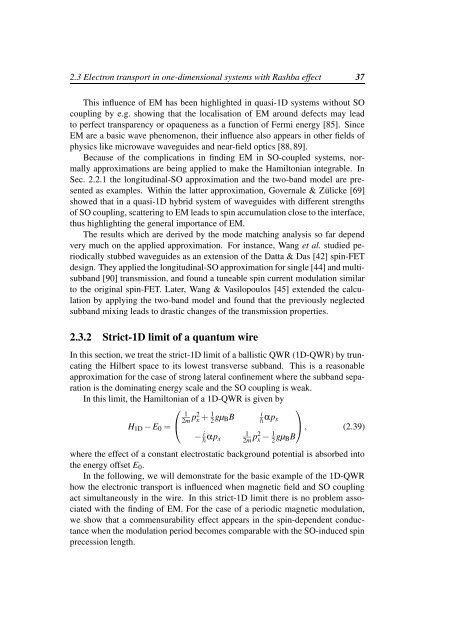Spin-orbit coupling and electron-phonon scattering - Fachbereich ...
Spin-orbit coupling and electron-phonon scattering - Fachbereich ...
Spin-orbit coupling and electron-phonon scattering - Fachbereich ...
You also want an ePaper? Increase the reach of your titles
YUMPU automatically turns print PDFs into web optimized ePapers that Google loves.
2.3 Electron transport in one-dimensional systems with Rashba effect 37<br />
This influence of EM has been highlighted in quasi-1D systems without SO<br />
<strong>coupling</strong> by e.g. showing that the localisation of EM around defects may lead<br />
to perfect transparency or opaqueness as a function of Fermi energy [85]. Since<br />
EM are a basic wave phenomenon, their influence also appears in other fields of<br />
physics like microwave waveguides <strong>and</strong> near-field optics [88, 89].<br />
Because of the complications in finding EM in SO-coupled systems, normally<br />
approximations are being applied to make the Hamiltonian integrable. In<br />
Sec. 2.2.1 the longitudinal-SO approximation <strong>and</strong> the two-b<strong>and</strong> model are presented<br />
as examples. Within the latter approximation, Governale & Zülicke [69]<br />
showed that in a quasi-1D hybrid system of waveguides with different strengths<br />
of SO <strong>coupling</strong>, <strong>scattering</strong> to EM leads to spin accumulation close to the interface,<br />
thus highlighting the general importance of EM.<br />
The results which are derived by the mode matching analysis so far depend<br />
very much on the applied approximation. For instance, Wang et al. studied periodically<br />
stubbed waveguides as an extension of the Datta & Das [42] spin-FET<br />
design. They applied the longitudinal-SO approximation for single [44] <strong>and</strong> multisubb<strong>and</strong><br />
[90] transmission, <strong>and</strong> found a tuneable spin current modulation similar<br />
to the original spin-FET. Later, Wang & Vasilopoulos [45] extended the calculation<br />
by applying the two-b<strong>and</strong> model <strong>and</strong> found that the previously neglected<br />
subb<strong>and</strong> mixing leads to drastic changes of the transmission properties.<br />
2.3.2 Strict-1D limit of a quantum wire<br />
In this section, we treat the strict-1D limit of a ballistic QWR (1D-QWR) by truncating<br />
the Hilbert space to its lowest transverse subb<strong>and</strong>. This is a reasonable<br />
approximation for the case of strong lateral confinement where the subb<strong>and</strong> separation<br />
is the dominating energy scale <strong>and</strong> the SO <strong>coupling</strong> is weak.<br />
In this limit, the Hamiltonian of a 1D-QWR is given by<br />
⎛<br />
1<br />
2m p2 x + 1 2 gµ ⎞<br />
i<br />
BB <br />
αp x<br />
H 1D − E 0 = ⎝<br />
− i αp x<br />
1<br />
2m p2 x − 1 2 gµ BB<br />
⎠, (2.39)<br />
where the effect of a constant electrostatic background potential is absorbed into<br />
the energy offset E 0 .<br />
In the following, we will demonstrate for the basic example of the 1D-QWR<br />
how the <strong>electron</strong>ic transport is influenced when magnetic field <strong>and</strong> SO <strong>coupling</strong><br />
act simultaneously in the wire. In this strict-1D limit there is no problem associated<br />
with the finding of EM. For the case of a periodic magnetic modulation,<br />
we show that a commensurability effect appears in the spin-dependent conductance<br />
when the modulation period becomes comparable with the SO-induced spin<br />
precession length.
















